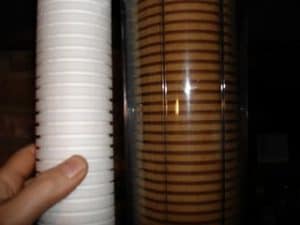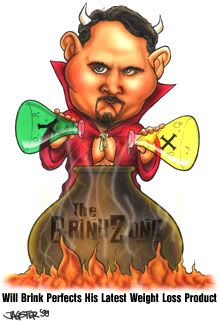The Facts About Muscle Fatigue
What actually causes muscle fatigue? It’s a build up of lactic acid right? Wrong. Readers will be interested to learn, lactic acid is not the cause of muscle fatigue, and, what actually causes muscle fatigue has been something of a mystery, which has only recently being elucidated.
The actual mechanism for muscle fatigue appears to involve the leakage of calcium. A recent article from the NY Times Online does a nice job of looking at the issue and is worth reading for anyone who wants to know the real deal of muscle fatigue beyond the outdated and incorrect lactic acid “build up” theory:
Finding May Solve Riddle of Fatigue in Muscles
NY Times online
By GINA KOLATA
Published: February 12, 2008
One of the great unanswered questions in physiology is why muscles get tired. The experience is universal, common to creatures that have muscles, but the answer has been elusive until now.
Scientists at Columbia say they have not only come up with an answer, but have also devised, for mice, an experimental drug that can revive the animals and let them keep running long after they would normally flop down in exhaustion.
For decades, muscle fatigue had been largely ignored or misunderstood. Leading physiology textbooks did not even try to offer a mechanism, said Dr. Andrew Marks, principal investigator of the new study. A popular theory, that muscles become tired because they release lactic acid, was discredited not long ago.
In a report published Monday in an early online edition of Proceedings of the National Academy of Sciences, Dr. Marks says the problem is calcium flow inside muscle cells. Ordinarily, ebbs and flows of calcium in cells control muscle contractions. But when muscles grow tired, the investigators report, tiny channels in them start leaking calcium, and that weakens contractions. At the same time, the leaked calcium stimulates an enzyme that eats into muscle fibers, contributing to the muscle exhaustion.
In recent years, says George Brooks of the University of California, Berkeley, muscle researchers have had more or less continuous discussions about why muscles fatigue. It was his work that largely discredited the lactic-acid hypothesis, but that left a void.
What did make muscles tired?
The new work in mice, Dr. Brooks said, “is exciting and provocative.” It is a finding that came unexpectedly from a very different line of research. Dr. Marks, a cardiologist, wanted to discover better ways to treat people with congestive heart failure, a chronic and debilitating condition that affects an estimated 4.8 million Americans.
Its hallmark is a damaged heart, usually from a heart attack or high blood pressure. Struggling to pump blood, the heart grows, sometimes becoming so large that it fills a patient’s chest. As the disease progresses, the lungs fill with fluid. Eventually, with congested lungs and a heart that can barely pump, patients become so short of breath that they cannot walk across a room. Half die within five years.
In his efforts to understand why the heart muscle weakened, Dr. Marks focused on the molecular events in the heart. He knew the sequence of events. As the damaged heart tries to deal with the body’s demands for blood, the nervous system floods the heart with the fight or flight hormones, epinephrine and norepinephrine, that make the heart muscle cells contract harder.
The intensified contractions, Dr. Marks and his colleagues discovered, occurred because the hormones caused calcium to be released into the heart muscle cells’ channels.
But eventually the epinephrine and norepinephrine cannot stimulate the heart enough to meet the demands for blood. The brain responds by releasing more and more of those fight or flight hormones until it is releasing them all the time. At that point, the calcium channels in heart muscle are overstimulated and start to leak.
When they understood the mechanisms, the researchers developed a class of experimental drugs that block the leaks in calcium channels in the heart muscle. The drugs were originally created to block cells’ calcium channels, a way of lowering blood pressure.
Dr. Marks and his colleagues altered the drugs to make them less toxic and to rid them of their ability to block calcium channels. They were left with drugs that stopped calcium leaks. The investigators called the drugs rycals, because they attach to the ryanodine receptor/calcium release channel in heart muscle cells. The investigators tested rycals in mice and found that they could prevent heart failure and arrhythmias in the animals. Columbia obtained a patent for the drugs and licensed them to a start-up company, Armgo Pharma of New York. Dr. Marks is a consultant to the company.
It hopes to start testing one of the drugs for safety in patients in the spring, but the tests will not be at Columbia because of the university and investigators’ conflicts of interest. In the meantime, Dr. Marks wondered whether the mechanism he discovered might apply to skeletal muscle as well as heart muscle. Skeletal muscle is similar to heart muscle, he noted, and has the same calcium channel system. And heart failure patients complain that their muscles are extremely weak.
“If you go to the hospital and ask heart failure patients what is bothering them, they don’t say their heart is weak,” Dr. Marks said. “They say they are weak.”
So he and his colleagues looked at making mice exercise to exhaustion, swimming and then running on a treadmill. The calcium channels in their skeletal muscles became leaky, the investigators found. And when they gave the mice their experimental drug, the animals could run 10 to 20 percent longer.
Then, collaborating with David Nieman, an exercise scientist at Appalachian State University in Boone, N.C., the investigators asked whether the human skeletal muscles grew tired for the same reason, calcium leaks.
Highly trained bicyclists rode stationary bikes at intense levels of exertion for three hours a day three days in a row. For comparison, other cyclists sat in the room but did not exercise.
Dr. Nieman removed snips of thigh muscle from all the athletes after the third day and sent them to Columbia, where Dr. Marks’s group analyzed them without knowing which samples were from the exercisers and which were not.The results, Dr. Marks said, were clear. The calcium channels in the exercisers leaked. A few days later, the channels had repaired themselves. The athletes were back to normal.
Of course, even though Dr. Marks wants to develop the drug to help people with congestive heart failure, hoping to alleviate their fatigue and improve their heart functions, athletes might also be tempted to use it if it eventually goes to the market.
The odds are against this particular drug being approved, though, cautions Dr. W. Robb McClellan, a heart disease researcher at U.C.L.A.
“In heart failure, there are three medications that improve mortality, but there have probably been 10 times that many tested,” he said.
Even if the first drug that prevents calcium leaks does not work in patients, Dr. McClellan added, the important advance is to understand the molecular events underlying fatigue. “Then,” he said, “you can design therapies.”
So the day may come when there is an antifatigue drug.
That idea, “is sort of amazing,” said Dr. Steven Liggett, a heart-failure researcher at the University of Maryland. Yet, Dr. Liggett said, for athletes “we have to ask whether it would be prudent to be circumventing this mechanism.”
“Maybe this is a protective mechanism,” he said. “Maybe fatigue is saying that you are getting ready to go into a danger zone. So it is cutting you off. If you could will yourself to run as fast and as long as you could, some people would run until they keeled over and died.”
The Brink Bottom line:
People – including some highly educated people who should know better by now -still perpetuate the myth that lactic acid “build up” is the cause of muscle fatigue. It’s been known for some time now that it’s simply not true. In fact, lactic acid is a fuel, not a foe, to tired muscles. What does cause muscle fatigue was unclear, but what was known was lactic acid “build up” was not the cause, yet most people to this day still cling to that false belief. Another article worth reading that came out a few years ago, is called Lactic Acid Is Not Muscles’ Foe, It’s Fuel! and was also published by the NY Times. From the article:
“Lactic acid is actually a fuel, not a caustic waste product. Muscles make it deliberately, producing it from glucose, and they burn it to obtain energy. The reason trained athletes can perform so hard and so long is because their intense training causes their muscles to adapt so they more readily and efficiently absorb lactic acid.”
“The notion that lactic acid was bad took hold more than a century ago, said George A. Brooks, a professor in the department of integrative biology at the University of California, Berkeley. It stuck because it seemed to make so much sense.”
“It’s one of the classic mistakes in the history of science,” Dr. Brooks said.
I recommend people read the above article on the latest model of muscle fatigue, then follow up with the article that looks at lactic acid specifically, which will give you the “big picture” on this topic.
Will Brink is the owner of the Brinkzone Blog. Will has over 30 years experience as a respected author, columnist and consultant, to the supplement, fitness, bodybuilding, and weight loss industry and has been extensively published. Will graduated from Harvard University with a concentration in the natural sciences, and is a consultant to major supplement, dairy, and pharmaceutical companies.
His often ground breaking articles can be found in publications such as Lets Live, Muscle Media 2000, MuscleMag International, The Life Extension Magazine, Muscle n Fitness, Inside Karate, Exercise For Men Only, Body International, Power, Oxygen, Penthouse, Women’s World and The Townsend Letter For Doctors.
He’s also been published in peer reviewed journals.
Will is the author of the popular e-books, both accompanied by private members forum access , Bodybuilding Revealed & Fat Loss Revealed.
You can also buy Will’s other books on Amazon, Apple iBook, and Barnes and Noble.







Great report will! Would this indicate in anyway that watching our calcium level could aid in reducing muscle fatigue?
Glad you enjoyed it. My guess is no, as calcium flux is very tightly regulated.
Great articles ! very interesting !
Love your “no-BS” blog. Keep going.
Will do! My blog is like my articles, site, or books, which are like me; no BS. 🙂
Great article, I found it very interesting. I am looking forward to hearing more on the research in years to come.
Hi GR8!!! Idea hope it goes from strength to strength. I have a bi of a problem in that i have picked up a repetitive strain injury in my elbow i want to continue training but my goals are to increase the size of my arms. There is a strap which can be worn around the forearm which is supposed to limit both pain and tendon movement. Will this affect my training. Hope you can help!!
Thanks Simon
Great info. I feel like I have been living in the dark here. It seems like just yesterday there were supplement companies and work out programs seeling their vudoo to help deal with latric acid build up. Thanks for the great info.
Marty
ok, so does ingestion of calcium help in ANY WAY?
better make it clear Will, i wouldnt want calcium supps to be more expensive, they are already overpriced.Heck, at this rate, eating egg shells seems like a good option!!!!!!!!!!!
Sam, I actually answered that question already above. As I said, “My guess is no, as calcium flux is very tightly regulated. ” However, there has been research using various buffers which did show promise for increasing endurance in the past.
More research is needed!
Cool, I learned something new today. I thought someone would posit the notion that it may not be a good idea to get around fatigue. Maybe you should be the first to try out any drug that comes along Will. Take it and run around the track for a few days and see if you drop dead. 😀 HA!
Incidentally, I see a new product to come out from MuscleTech: “Try our new Calcium Flux Capacitor! It blocks calcium leaks to give you peak energy FOR HOURS!!!”. God give me strength…..
Swimming more is my new years resolution for 2009. I just wish I had my own pool
What a interesting and detailed report! I definitely learn a lot from this report. I am only 13 years old and cannot really understand certain parts of the report. Pardon me of my ignorance 🙂 I see a lot of depth in this report though it may be simplified quite a lot for readers like me… However I will shared this infomation will my friends to let them know of the truth. Its calcium leakage that made our muscles tired not lactic acid!
Hey Will, Nice to see you give attention to the endurance athletes out there. I was heavily into rowing a few years back and got all into the science of respiration and energy mechanisms of all sorts. I think Brooks gets too much credit for the knowledge of benefits of lactic acid. I have an old CD ROM program that is european that shows the pathway of burning lactic acid as fuel. That pathway has been known for decades. Lactate (which is not even quite the same as Lactic Acid) is still a good indicator of one's endurance ability. There is a whole methodology of taking finger stick blood samples and measuring and plotting lactate to see how well your body is processing that fuel. Having very high levels of lactate in your system after a hard sprint, is still and always will NOT be a good thing. But, I think the point is, it is an indicator, and not the cause.
That was perfect..but the question stands that..Is Calcium leaky channels the only answer for this ..or can that be more accumulation of Lactic acid , H+ ions , As the muscles works and works the lots of heat is generated and ATPs lost and few protiens get burned and few proteins channels also get dissolved and that Vmax for transport of Ca into is achieved..so on
i have congestive heart failure for whichi take coumadin, plavix lasix,,,lipitor,,coreg. which of these meds causes my muscle fatigue ?
I don’t believe it is leaky calcium either – though this may have an effect on long term muscle function (i.e. sarcopenia). Muscle failure is probably a natural mechanism whereby the cell detects low ATP levels and prevents nerve stimulated release of calcium, which is needed to trigger a contraction.
ATP is needed for the muscle proteins to end a contraction (i.e. the cause of rigor-mortis is lack of ATP causes all muscles to contract), thus, this mechanism would be protectant against cramping.